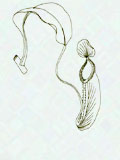

 |
 |
Vertebrates
| A view to a kill - the mythologisation progress in action | |
| Wildlife around the HKU campus? | |
| An Ardeid population of regional importance | |
| Should Hong Kong's freshwater fishes be protected by law? |
Should Hong Kong’s freshwater fishes be protected by law?
by Bosco P. L. Chan
The Country Parks Ordinance (Cap. 208) affords full protection to terrestrial wildlife living in our protected-area system. The Wild Animals Protection Ordinance (WAPO, Cap. 170), which is intended to "make provision for the conservation of wild animals (of Hong Kong), and for purposes connected therewith" (Cap. 170, Section: Long title), lists over 500 species of wild animals, some aliens included, living in Hong Kong. WAPO covers all birds, all mammals except rodents (but including the porcupine), shrews, and wild boar, some reptiles and amphibians, which cannot be killed or wilfully disturbed anywhere in the SAR. Surprisingly, WAPO does not include any of Hong Kong’s native fishes. In actual fact "animal" in this particular ordinance means any form of animal life except fish and marine invertebrates (Amended 58 of 1980 s. 2). Since the enactment of the Environmental Impact Assessment Ordinance (EIAO, Cap. 499) in 1997, and under the evaluation criteria of the EIA Technical Memorandum (EIATM, Cap. 499, s. 16), the WAPO also serves as an important reference in evaluating a study site’s ecological value; i.e. if a species is found by the ecological consultant, then the ecological importance of the study site is assessed, amongst other criteria, by whether the species concerned is listed in local protected species law. From time to time, local conservationists call for the amendment of WAPO to include certain taxa believed to be threatened with local extinction, due to the inadequate coverage of WAPO. But up until now no concrete action has been taken by relevant government departments.
From direct and indirect sources, I was told that WAPO aims to list local species that are believed to be threatened by active trapping and/or collecting pressure, and that rare species which are endangered by other means of threats are not included. During the last few years, I have spent a considerable amount of time wandering around Tung Choi Street in Mong Kok, which because of its booming pet market is better known as ‘Goldfish Street’ by locals. During this period I have seen a slow increase in the trade of native, or locally-collected freshwater fishes. For instance in 1997-1998, only a small amount of the common hillstream species, such as Parazacco spilurus, Liniparhomaloptera disparis disparis, and Rhinogobius duospilus were offered for sale. Recently, however, both the number of species and quantity of fish collected from Hong Kong seem to have escalated. Below is a list of native fish species which I observed for sale in Tung Choi Street in 2001. Those marked with an asterisk were seen regularly and in relatively large number (i.e. over 50 individuals per visit). In addition, the native snakehead Channa asiatica is also offered regularly. The small size and small trade quantity makes importation very uneconomical, and these individuals are believed to be caught locally.
*Parazacco spilurusNicholsicypris normalis
*Puntius semifasciolata (not to be confused with the captive-bred variety)
Acrossocheilus hemispinus
*Pseudogastromyzon myersi
*Liniparhomaloptera disparis disparis
*Schistura fasciolata
Pseudobagrus trilineatus
*Rhinogobius duospilus
Stiphodon atropurpureus
Macropodus concolor (not to be confused with the captive-bred variety)
*Macropodus opercularis
The most worrying is the appearance of some highly restricted and recently reported species, in particular since 2000. The most astonishing of all is doubtless the beautiful neon goby Stiphodon atropurpureus, first reported in Hong Kong as Stiphodon sp. (Chan, 1999). Four pairs of this beautiful and locally rare goby were seen for sale in a shop, which has a regular supply of locally collected fish and other aquatic animals (including metamorphosing Hong Kong Newt Paramesotriton hongkongensis). This tiny animal, measuring no more than 5 cm in total length and 5 grams in weight, was priced at $550 Hong Kong Dollar for a pair! Therefore there is a very good reason for a schoolboy or retired hobbyist to collect every single one they manage to find, and the collecting pressure is probably as high as any wildlife species you can imagine living in Hong Kong. Three other native species of particular conservation concern were observed also; the markedly-striped catfish Pseudobagrus trilineatus was $88 dollar each, and it is known from three tiny sites in Hong Kong. The barb Acrossocheilus hemispinus, known from a few valleys locally, was selling for $40 per fish. The globally restricted Black Paradise Fish Macropodus concolor sells for $40 each. The Paradise Fish Macropodus opercularis is a lot cheaper; each adult only costs $10. This is no surprise because I personally witnessed two very hard-working gentlemen scooping up well over 80 M. opercularis out of the Pui O Marsh last year. Even the established exotic species, such as Platy Xiphophorus variatus, Molly Poecilia sphenops and snakehead Channa striata, are for sale from time to time.
With the frequency of occurrence in trade and the high prices they can fetch, it is highly recommended that AFCD should consider listing native freshwater fishes in the WAPO. In fact the WAPO itself should be revised to provide total protection to the listed animals; the ordinance specifies, for example, that only when a protected animal offered for sale is taken in Hong Kong is it considered an offence. The sale of metamorphosing Hong Kong Newts, as an example, is difficult to regulate because the shop owner can always claim these animals are from outside Hong Kong so long as the species is not CITES-listed and requires no export/import permits. If nothing else, at least their habitats can be safeguarded when our EIA consultants reference the revised WAPO if some of these species are listed.
Bibliography
Chan, B. (1999). Hong Kong’s Freshwater Fish: Who Cares?!? Porcupine!
|
|
P.13-14 |
|
Porcupine! |
 Copyright © 2000 |